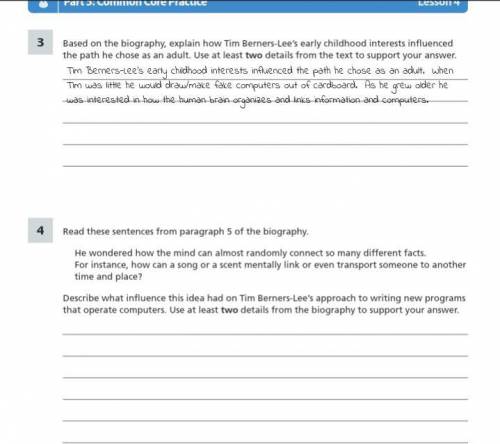
English, 13.05.2021 03:00 SupremeDiaz17
Extraordinary People: Tim Berners-Lee from HowStuffWorks online1 Most people know that Thomas Edison invented the light bulb and that Alexander Graham Bell invented the telephone. But have you ever heard of Tim Berners-Lee?2 Probably not, yet the work of Berners-Lee, the inventor of the World Wide Web, may have the most profound impact of all. Why is his name unknown to most of the world? The answer lies in the type of life he has chosen to lead and the role he has chosen to play in helping to guide this emerging technology.3 If you were in a time machine and could travel back to 1960s London, you might find young Tim Berners-Lee busily constructing make-believe computers out of cardboard boxes or playing mathematical games with his parents at their kitchen table. Tim is fascinated by the world around him. His natural curiosity attracts him to a dusty Victorian-era encyclopedia he finds in his house; its mysterious title, Enquire Within Upon Everything, will stay with him for years to come.4 Fast-forward to 2001. Over 250 million people are using the Internet, a system virtually unheard of 10 years earlier, and Tim Berners-Lee is largely responsible. How could one person make it all happen?5 For some clues, let’s go back to Tim’s early adulthood. Tim was especially interested in two things: computers and how the human brain organizes and links information. He wondered how the mind can almost randomly connect so many different facts. For instance, how can a song or a scent mentally link or even transport someone to another time and place? Tim was so fascinated by computers that, before graduating from the University of Oxford, he built his very first one from a kit using a television and an early microprocessor.6 In 1980, after graduating with a degree in physics, Tim went to work as a software engineer for an organization in Geneva, Switzerland. His job required a lot of research. He communicated with people all over the world and he was constantly answering the same questions over and over. He was frustrated by how poorly his mind could remember all of the reports and data he needed. He wished there were a way other people could simply access his data and he could access theirs via computer no matter where they were located.7 Tim wrote a software program to help him keep track of important documents and, using a series of links (hypertext), he connected them together much like an index does in a book. He named the program Enquire after the book he loved as a child. In its original form, Enquire was capable of storing information and connecting documents electronically, but it could only access information on a single computer.8 In 1989, Tim took a giant step towards his vision of a global system where documents could be linked via hypertext to the Internet, allowing people worldwide to easily share and link information. After much thought, he called his project the World Wide Web. Many people thought that connecting documents stored in individual computers around the world was impossible.9 And even if it were possible, few of his fellow scientists thought it would ever become popular. Lesson 4 ©Curriculum Associates, LLC Copying is not permitted. L4: Analyzing Interactions in a Text 33 Part 5: Common Core Practice 10 Tim was not discouraged. Working with a few colleagues who supported his vision, he developed the four critical foundations of the Web: The language for coding documents (HTML); the hypertext system for linking documents (HTTP); the system for locating documents on the Web (URL); the first graphical user interface (Internet browser). In 1991, the Web was launched and almost immediately, the Internet took off. 11 Although he has had many opportunities to do so, Tim has not profited from his creation. . . . [He] works for a non-profit organization located at M. I.T., a leading engineering university. Married with two children, Tim leads a good life, one that is full of professional challenges. He is pleased with the road he chose to follow. Today, he helps set standards and guides the Web’s future, so he can be assured that it will remain open to all and not be splintered into many parts or dominated by one corporation. However, like Einstein, who was concerned with his role in the development of nuclear power, Tim believes that technology can be used for good or for evil. “At the end of the day,” Tim says, “it is up to us: how we actually react, and how we teach our children, and the values we instill.” To this day, Tim Berners-Lee works hard to see that the technology he invented remains accessible to all people around the globe. That, rather than instant wealth, is his reward.


Answers: 1


Another question on English

English, 21.06.2019 17:20
Which sentence correctly use quotations from “a modest proposal”
Answers: 1

English, 22.06.2019 02:00
What evidence does the author provide to demonstrate bach natural musical talent
Answers: 3

English, 22.06.2019 02:00
According to auden’s “musée des beaux arts”, who understands human suffering
Answers: 3

English, 22.06.2019 05:30
Drag each excerpt to its poetic structure. what poetic structures are evident in these poetry excerpts blank verse ballad stanza something there is that doesnt love a wall
Answers: 1
You know the right answer?
Extraordinary People: Tim Berners-Lee from HowStuffWorks online1 Most people know that Thomas Edison...
Questions


Chemistry, 21.08.2020 22:01

Mathematics, 21.08.2020 22:01


Mathematics, 21.08.2020 22:01

English, 21.08.2020 22:01


Mathematics, 21.08.2020 22:01



Mathematics, 21.08.2020 22:01

Mathematics, 21.08.2020 22:01

Mathematics, 21.08.2020 22:01









